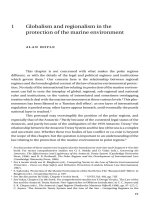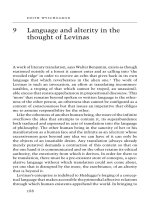PEOPLE AND PLENTY IN THE TWENTY-FIRST CENTURY
Bạn đang xem bản rút gọn của tài liệu. Xem và tải ngay bản đầy đủ của tài liệu tại đây (187.91 KB, 12 trang )
295
CHAPTER
27
PEOPLE AND PLENTY
IN THE TWENTY-FIRST
CENTURY
There is no more intriguing problem in the history of food than that
of how cultural barriers to the transmission of foods and foodways
have been traversed or broken.
Felipe Fernández–Armesto
1
ANOTHER LARGE and daunting twenty-fi rst century problem involves
equal access to food. Today, fertility rates in third-world countries have
decreased sharply even as global per capita calorie consumption has risen,
the twin phenomena casting doubt on predictions of swelling populations
outstripping the globe’s food supply.
2
Such predictions were routinely
generated by that alarming increase in the number of people occupying
planet Earth between 1900 and 1990, which was the equal of four times
the sum of all previous increases in the whole of human history.
3
But
although we are now 6 billion, with predictions of an increase to 9 billion
by 2050, it would seem that agricultural advances have probably resolved
concerns about food quantity. There are enough calories for everyone. Yet
fully three- quarters of the world’s population derive their calories from
a diet that is low in high-quality protein compared to the other quarter
who consume too much of it in diets that are defi nitely not tailored for
a small planet. And the problem is, as Tony McMichael points out, that if
food consumption was somehow made equal in terms of quality, the globe
296
A Movable Feast
could not currently support our 6 billion; to do so would require two extra
planet earths given our current technologies, and to support 10 billion
would require four extra earths.
4
It is both a protein problem and a caloric conundrum. Two extra earths
are hard to come by, let alone four. As a rule, per capita food consumption
is lowest where population pressure is greatest and the food consumed is
of poor quality. But few of us are callous enough to think that it serves the
low food consumers right. In the long run, with education and increasing
wealth, such populations should shrink, but in the short run, the only way
for their food consumption to increase is through the exercise of still more
of the new and better technologies that humans have been coming up
with since the beginnings of agriculture. One of these is plant breeding –
carried out since those beginnings – which today means that we have low
carb potatoes, broccolini, and brocofl ower; that sunfl ower yields have been
increased by up to 20 percent through utilizing hybrid vigor;
5
and that
the soybean, once a subtropical plant, can now be grown in latitudes as far
north as 52 degrees, so that U.S. soybean fi elds begin their march south-
ward from Minnesota.
6
Until now, we have looked at the Neolithic Revolution as if it were
something that happened a long time ago. From another angle, however, it
is still ongoing – a process of agricultural evolution. It took 10 square kilo-
meters to support a single hunter-gatherer. With the advent of traditional
farming those 10 square kilometers supported 500 people and as many as
1,000 in fertile river plains. Today’s intensive developed-world agriculture
can support some 3,000 persons on 10 square kilometers.
7
The Green Revolution and genetically modifi ed ( GM) foods may, there-
fore, be regarded as the latest manifestations of an ongoing Neolithic Revo-
lution. The Green Revolution, with its roots already growing during World
War II, was aimed at increasing the productivity of developing world agri-
culture. Not surprisingly, in view of the hemispheric interest of the U.S.
government and the Rockefeller Foundation (who might be considered
Green Revolution founders), the focus fell fi rst on maize as a revolution-
ary crop and Mexico as the place to launch the revolution.
8
By the 1960s,
high yielding wheat strains were also under development in Mexico and
these, too, subsequently colonized the world.
9
Advances in wheat were
paralleled by a Green Revolution in tropical rice, thanks to the efforts of
the International Rice Research Institute located in the Philippines, which
concentrated on high-yielding semi-dwarf varieties.
10
People and Plenty in the Twenty-First Century
297
Truly sensational yields of rice and wheat and maize followed, but
unintended consequences took the edge off the excitement that such
yields generated. Technological improvements tend to benefi t developed
countries most, and the United States managed to double its wheat pro-
duction in just a quarter of a century.
11
In large part this was because
Green Revolution cultivars were heavily dependent on the petrochemical
industry for fertilizers, which U.S. farmers could afford even in the face
of soaring oil prices in the 1970s. But such prices meant disaster for poor
developing world farmers who lost their farms to rich ones.
Another problem – recognized by 1970 – was the displacement and dis-
appearance of a wide variety of cultivars and, consequently, of the genetic
variability that had enabled plant breeders to produce those few currently
in use. Past corn breeding, for example, now portends potential GM trou-
ble because practically all maize grown commercially comes from a small
pool of hybrid seeds whose traits are so unpredictable in the second gen-
eration that new seeds must be purchased every year. This is profi table for
hybrid seed corn companies, but makes for such genetic uniformity that
maize crops are all equally vulnerable to new diseases, pests, and insects
and, thus, to widespread crop failure.
12
Similarly, the new dwarfed and semi-dwarfed wheat and rice plants
are also genetically uniform, which means that a growing amount of the
world’s food supply is at risk from new, or newly mutated, plant pathogens.
Nor were the hybrids defending themselves all that well against existing
pathogens. More chemicals were brought to bear – especially pesticides
whose cost drove still more Third World farmers out of business, and
whose effects ignited environmental furor in the developed world.
13
Finally, perhaps the most discouraging unintended consequence of the
Green Revolution was to initiate a tremendous increase in those popula-
tions that supposedly were going to be able to feed themselves. Instead,
they reproduced to the outer limits of their food supply and, by the 1980s,
every country “revolutionized” by the Green Revolution was once again an
importer of those staple foods they had expected to be able to export.
Despite this kind of adversity, however, the world’s farmers did triple
yields between 1965 and the 1990s, and this without yield variability rising
signifi cantly. Much of the thanks for this was due the rediscovery of Men-
delian Genetics in 1900 that gave rise to food biotechnology a half-century
later, which means the use of recombinant deoxyribonucleic acid (rDNA)
and cell fusion techniques to introduce new traits into plants, animals,
298
A Movable Feast
and microorganisms. Such gene transfers between different species have
occurred often enough in nature. But it was only in the aftermath of the
mid-century discovery of the roadmap of life (the double helix structure of
DNA) by James Watson and Francis Crick that humans have been able to
control the process. This has been heralded as the greatest breakthrough in
agriculture since its invention – even the beginning of a second Neolithic
Revolution – and one that promises even more agricultural transformation
and an array of other sparkling possibilities.
14
As was learned from the Green Revolution, however, its management
will require the imposition of some sort of analytic framework – a care-
fully drawn map if you will.
15
Critics say that this sort of management is
impossible but, managed or not, biotechnology is not going to go away.
With the prediction of a global population increase from 6 to 9 billion by
2050, technology and science have their work cut out for them, and bio-
technology promises a food supply capable of feeding the extra 3 billion
of us – even on the poor soils and in the poor climates that characterize
many of the developing countries.
16
GM events have moved at blinding speed since 1994 when the “Flavr
Savr” tomato became the fi rst genetically engineered food product
approved by the FDA for human consumption in America. Two decades
later it was announced that the DNA code of rice had been deciphered,
and doubtless the codes of the other major world crops will soon follow,
to add still other dimensions to GM foods. At present the United States,
Canada, and Argentina account for the bulk of the world’s GM food crops
(China and South Africa produce GM cotton) and have concentrated on
modifying ripening characteristics, and developing resistance to herbicides
and insect pests.
The focus was initially confi ned mostly to soybeans and corn in the
United States and canola in Canada but, because of the many uses of these
crops as food additives, Americans unwittingly began consuming GM foods
almost daily. Fully 80 percent of the nation’s soybean crop has been geneti-
cally altered with the addition of a gene from a bacterium that makes the
plant resistant to a widely-used weed killer, and at least a third of the corn
produced has a gene from another bacterium that kills insects. The modi-
fi cation of potatoes and sugar beets has also received much GM attention,
and such novelties as melons with edible rinds, fully mature cheeses made
barely a week before, and avocadoes with seeds in the skin instead of a pit
in the center, are among GM’s “near-future” promises.
17
People and Plenty in the Twenty-First Century
299
During much of the 1990s, the controversy that greeted the fi rst GM
products on the market seemed to pass right over the heads of Americans,
who only took notice of this new development in their food supply when
European (and some Asian) governments worried openly about possible
health and environmental hazards embedded in GM foods and insisted that
they (and products containing GM ingredients) be labeled to give con-
sumers a choice. But because soybeans are employed in over 60 percent of
the processed foods Europeans buy from America, this meant that trans-
genic, herbicide-resistant soybeans from the United States would have to
be sorted out from the traditionally grown varieties – a costly procedure.
Nonetheless, in the late 1990s the European Union ( EU) responded to con-
sumers’ fears about the safety of GM foods (85 to 90 percent of Europeans
wanted GM foods to be labeled) by enacting a moratorium on their sale.
18
Such fears of GM foods are as disparate as the groups that voice them.
Some object to scientists “playing God.” Others worry that consumer ill-
health will be the chief harvest of GM foods, and still others are anxious
about unintended environmental consequences – GM crops, for example,
escaping and crossing with wild relatives to touch off an epidemic of
“super weeds.”
19
In addition there is the very real possibility that the bugs
and weeds GM foods are built to discourage may instead build their own
defenses against such efforts. Many, with little confi dence in the ethics of
GM producers, suspect that the new plants will be outfi tted with “termi-
nator” genes to kill them before seed can be collected for planting, thereby
chaining developing world farmers to Western agrochemical fi rms. Still
others just don’t like big business, or have specifi c objections to companies
like Monsanto with its “seed police” who nose around small towns looking
for tips on who might be saving Monsanto seed. Those caught are sued and
one poor farmer actually went to prison for the offense.
20
The food and biotechnology industries denounced the European mora-
torium as a “knee-jerk” reaction or a “frankenfoods” phobia. Washington
(backed by Canada and Australia) claimed that it constituted an illegal
trade barrier that would cost U.S. farmers hundreds of millions of dol-
lars annually, and fi led a complaint with the World Trade Organization.
By the middle of 2003 the smoke was clearing. The European Parliament
had passed tough new laws regulating GM foods, to replace the biotech
ban – laws that dismayed the U.S. administration. Not only are Europeans
getting their labeling, but the regulations state that producers must trace
genetically modifi ed organisms at all stages of production. Finally, European









